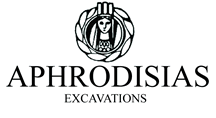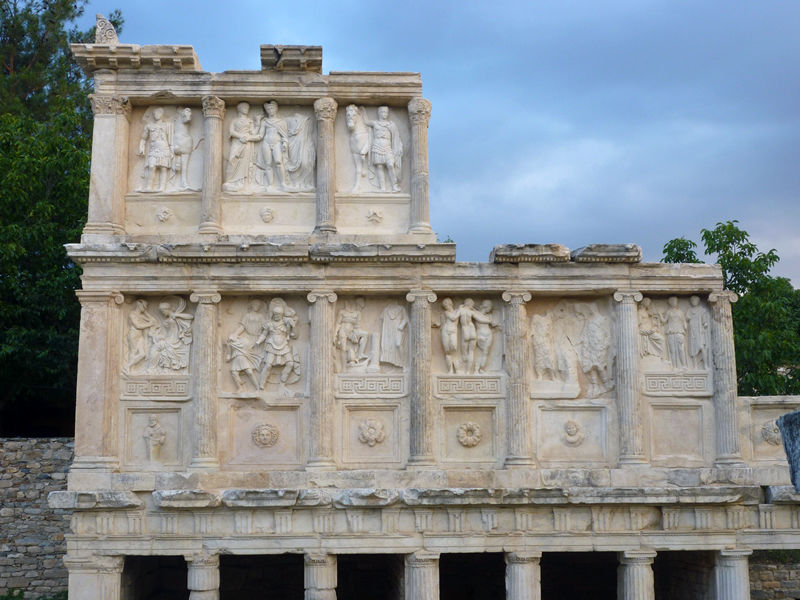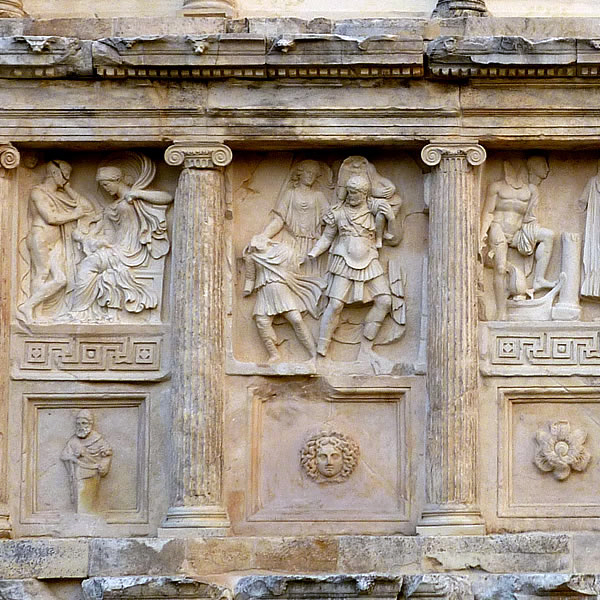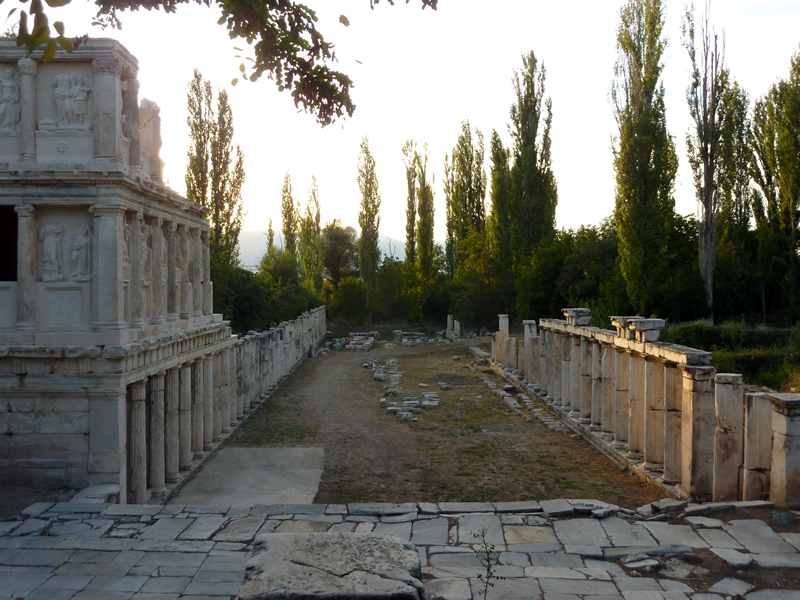Sebasteion
The Sebasteion, excavated in 1979-81, was a grandiose temple complex dedicated to Aphrodite and the Julio-Claudian emperors . Its construction stretched over two generations, from c. AD 20 to 60, from the reign of Tiberius to that of Nero. The complex was paid for by two prominent Aphrodisian families. It consisted of a Corinthian temple and a narrow processional avenue (90 x 14 m) flanked by two portico-like buildings, each three-storeyed (12 m high), with superimposed Doric, Ionic, and Corinthian orders. These North and South Buildings, which defined the processional avenue, carried marble reliefs in their upper two storeys for their whole length. The reliefs were framed by the columnar architecture so that the two facades looked like closed picture-walls. Some 200 reliefs were required for the whole project, and more than 80 were recovered in the excavation. They featured Roman emperors, Greek myths, and a series of personified ethne or ‘nations’ of Augustus’ world empire, from the Ethiopians of eastern Africa to the Callaeci of western Spain. The Sebasteion reliefs are close to contemporary historical interest in the visual culture and city life of the Greek East under the Roman empire. A new museum hall displaying the Sebasteion reliefs was opened at the Aphrodisias Museum in 2008.
South Building reliefs: emperors and heroes
The South Building was sponsored by two brothers, Attalos and Diogenes, and their family. Some eighty per cent of its reliefs survive, and its programme can be followed in detail. The third storey juxtaposed figures of the traditional gods with figures of the early Roman emperors and scenes of their conquests (Claudius over Britannia, Nero over Armenia). The emperors are here shown as new, active members of the traditional Olympian pantheon. In the lower storey, there was a remarkable series of mythological scenes, featuring Greek and local heroes and their exploits (Herakles, Telephos, Bellerophon, Achilles, Aineias). The heroes, great benefactors of mankind, make clear points of comparison for the emperors above. Some of the reliefs also make closer connections between the local goddess Aphrodite, her son Aineias, and the Julian emperors in Rome. The sequence of the reliefs can be reconstructed from their find-places in the excavation.
The subjects of the reliefs in the third storey are Roman emperors, imperial victory, and the Olympian gods. The emperors are represented as powerful warrior divinities and are mixed with the old gods as near-equal partners. They are, as one of the building inscriptions calls them, Theoi Sebastoi Olympioi, or ‘Olympian Emperor Gods’. World rule is secured by the pantheon of old and new divinities. The reliefs were arranged in groups of three: a wider relief flanked by two narrower ones, with the wider relief placed above the doorway into each of the 15 rooms behind the façade. The main early Roman emperors are present: Augustus, Tiberius, Claudius, and Nero, with younger princes and imperial women. Their most important activity is victorious war over barbarians, and they are represented in hellenistic heroic style.
North Building reliefs: peoples of empire
The North Building was built by two brothers, Eusebes and Menandros, and their family. Its third storey featured a series of universal allegories (Day, Ocean) mixed with imperial scenes (Nero with his mother Agrippina). This series is the least well-preserved of the complex. The second storey contained the long series of personified nations of the Augustan empire, each pictured as a statue between the columns of the architecture. An inscribed label named each figure — for example, ethnous Dakōn, ‘of the people of the Dacians’. The idea was a visual listing of Augustan world empire. The places and peoples were among those claimed as conquered or brought into the empire under Augustus. The selection emphasised wilder peoples on the edges of empire. Few in Aphrodisias can have heard of many of them. The idea, the list, and the images were probably borrowed directly from a monument in Rome.
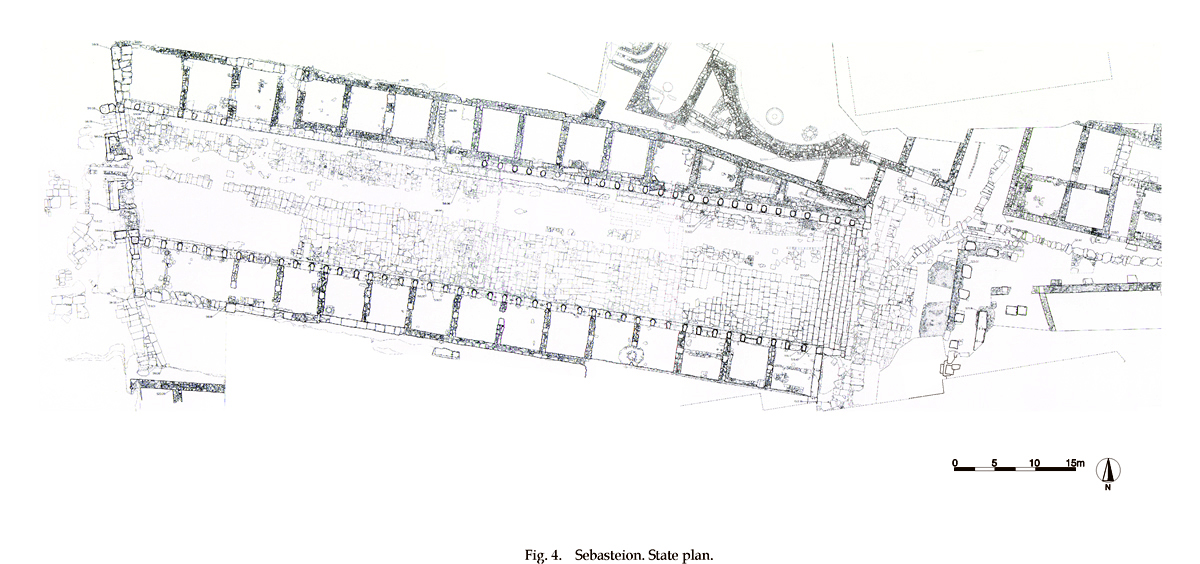
Finds: Sebasteion reliefs
